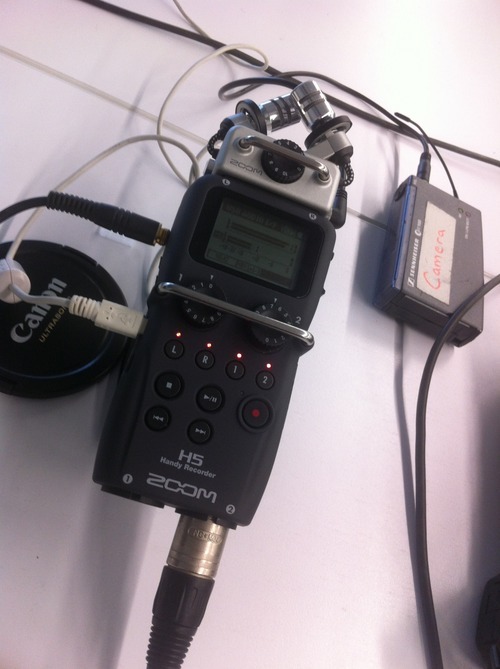Simple task: Help Brian and Alan capture audio of his Tuesday lecture for the Google Hangout session. Couple of problems presented immediately; one, how to get the best quality of Alan’s talk and still get decent audio of the room since people will be answering questions and Alan will be playing video clips to the room.
I have a couple different workflows for when I am recording this type of thing on video. The camera I use has two XLR inputs so I connect a lav or lapel microphone to one input and another microphone to the other. I can monitor the audio levels visually and with my headphones.
Great but for this set up we are not using a video camera, and the audio needs to go into Brian’s laptop. Ah ha, the new Zoom H5 audio recorder can act as an audio interface, meaning it is not acting as a recorder but as a mini mixer. Haven’t used this device a lot yet, but I know I can input the lav into the mini-jack input and two other mics into the xlr inputs. Perfect, small and portable elegant solution.
I set up one omnidirectional mic to capture the room sound, and hook up a lav onto Alan. Okay, why aren’t I hearing anything from the room mic? Levels are up, power to the mic is on, input is correctly set. WTF? No sound from the mic. Shake the cable and notice static on the meters. mmm. Un plug cable and try another cable. Luckily I was taught to always bring extras. Yup it’s the cable. Whew.

Room microphone is not the best set up, the room itself is noisy and is made even noisier when I have to turn up the gain to hear questions from the back of the room. But crystal clear audio on Alan’s voice which is really what is important.
So again, I learned that I don’t prepare enough and I can think pretty fast on the fly and usually solve problems as they arise. Scary. Once I got to the office I figured out that I could have plugged both the lav and the area mic into the xlr inputs on the bottom of the H5 and then also used the built in x/y microphone on the top of the device. Next time.
